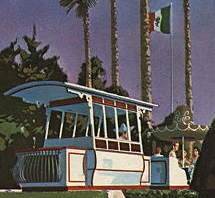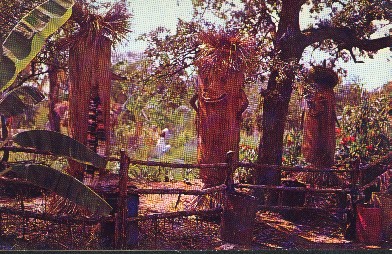Last Year Operated: 1978
Section: Mexico
Manufacturer:
Other Names and Nicknames: Hat Train
Ferrocarril Fiesta Train
1961 – 1978
The Ferrocarril Fiesta Train was the type of ride that defined the early years of Six Flags. Located in the Mexican Section, the well themed and colorful ride was enjoyed by everyone, from the very young, to the very old. It opened with the park in 1961, and entertained guests until it was removed after the 1978 season.

The ride consisted of two diesel-powered narrow gauge trains which carried guest through a series of light-hearted animations themed to a colorful Mexico. One of the trains was named “El Cho Cho”, the other “El Cha Cha.” The original passenger cars had large sombreros for tops, earning the ride the nickname, “The Hat Train.”
Like the larger Six Flags Railroad, the Fiesta Train was a narrow gauge railroad.
The two railroad trains consisted of nine little square cars, each of which seat four adults. All were painted in bright pastel colors. For a roof, each of the cars had a giant colorfully painted sombrero, leading to the ride eventually being called the “Hat Train” and the “sombrero train”.

The engines slightly resembled street cars, with a rectangular structure. The ride was an outdoor “pretzel” style ride; that is a ride whose track curves in and out several times, like a giant pretzel. This allows different isolated scenes to be observed by the riders, without being distracted by the next or last scene.
The trains pull away from the small station to loudly playing Mexican music. Around the first bend riders viewed an animated band of Mexican musicians, dressed in white with large sombreros, constantly playing their pleasant tunes. The train turned another bend and riders spotted a troop of dancing tamales, as tall as people, each also wearing a large sombrero. The tamales constantly spinned as they dance to another gleeful song.
Around the next bend was a more comical scene, a group of oversized travelers, sitting on much too small burros, rocking back and forth as they head to some unknown destination. They too wore large colorfully sombreros.
When the ride was redecorated in 1968, the dancing Tamales and oversized burro riders were moved to the railroad ride, where they are now seen from the train ride.

The next bend revealed a sleepy little village, where characters in large sombreros took their siesta in the afternoon sun. Another scene was the “Gardens of Xochimilcho”, with its picturesque scenery, a small pond, with a fountain and small boat. Another mariachi band performed at the gardens.
The final scene was a bull fighting arena, the Plaza De Los Toros, where a matador challenges a large black bull, while a crowd wearing large sombreros cheers him on. As the bull moves through its paces, it appears for a moment that it is charging the train, leaving the riders with a little fright. The trains then pulled back into the station to end the ride.

For the 1968 season, the trains and animations were completely redesigned by Sid & Monty Krofft. The engines were redesigned as dragons and the trademark sombreros were replaced with more traditional cars. The central component of the remodeled ride was a Volcano which dominated the section’s landscape. A small stream of “lava” flowed down the volcano, which “erupted” every few minutes with a loud “boom”.
While still a family ride, the graceful scenes were replaced with more exciting ones. Mexican children, singing the ride’s trademark “Fiesta” song, danced at the station. A “run-away bus” served as the remodeled rides first animation.
The train entered into the volcano and exited in the middle of a Mexican town. A gun battle was taking place in the town, and the train passed through the middle of it. Peaking from one window was Batman and Robin, foreshadowing their later more major role in the park. The shoot-out scene in Bugs Bunny’s Gold River adventure is very reminiscent of this scene.

The ride ended with a trip through a circus, in which numerous animated characters performed various feats to loud music.
The La Vibora Ride, (originally, the Avalanche Bobsled), is now located in the general area in which the trains ran.
